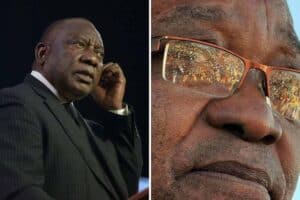Bosasa's capture of politicians saw it rake in R2.3 billion from state tenders.

To ensure it secured lucrative state tenders, Bosasa came up with elaborate schemes to keep politicians in its pockets while raking in billions in the process.
The influence and gratification of the politically connected was at an “industrial scale”, the third part of the State Capture Commission of Inquiry‘s report into the massive corruption scandal showed. The report’s 1,000 pages details how the now defunct Bosasa managed to capture a former president, some members of his executive and other government officials.
With the late Gavin Watson at the helm, Bosasa made an estimated R2.3 billion, between 2000 and 2016, from tenders across government departments.
Former COO Angelo Agrizzi, who turned whistleblower, testified before the Zondo commission that at least R75 million in bribes were paid during the 16 year period.
The report stated that the cash generated by Bosasa’s operations was, however, not enough to keep up with the periodic bribes in cash, gifts, and home renovations. Bosasa had to find other means to ensure the constant cash supply.
ALSO READ: State capture report: Mantashe seen by Bosasa leadership as ‘brilliant connection’
“The evidence revealed the attempts to influence were carried out at what can be characterised as an industrial scale, requiring mechanisms to secure an ongoing generation and delivery of cash in quantities that were not feasible through normal trading operations.
“Cash generation units, such as the canteen at Lindela [repatriation centre] were not the main source of income for Bosasa, hence the need for the illicit mechanisms for large scale cash generation and the need for substantial vaults at Bosasa offices where the cash could be stored and processed.”
‘Level of influence’
After courting an individual, Bosasa bosses would then decide how much to pay them based on the level of influence that person could exercise.
According to the report, the company sought to do this on a continuous basis. Houses were built and furnished, security installed and cars, gifts, jewellery and groceries were bought to curry favour.
Bosasa created fake invoices for non-existent labour brokers and even paid ghost employees. Another method for the illicit scheme involved using copies of funeral scheme payments as sources for cash cheques. Liquidated companies and wholesalers were also used and labelled as “suppliers”.
ALSO READ: Bosasa’s ‘corrupt business model’ takes centre stage in Part 3 of State Capture report
All the cash generated from the illegal schemes was stored in Watson’s walk-in vault in his office. There was at least R2 million in cash in the vault at any given time. At times the amount of money stored in the vault exceeded R6 million.
As a show of force and influence, Watson made it a point to bring captured politicians and officials to the once sprawling Bosasa head office in Krugersdorp. They would be given a tour of the premises and some would leave with bags of cash from his vault.
Members of the executive, such as former president Jacob Zuma, ANC NEC member Nomvula Mokonyane, former finance minister Malusi Gigaba and many others, were treated to personal tours by Watson.
“Agrizzi, along with other witnesses, testified that Bosasa and the Watson family established a reasonably well-organised, well-placed network of powerful people whose loyalty was secured with financial and other material incentives and bribes.
“It was through this network that they were able to promote and protect the private interests of Bosasa by irregular practices to extract money from the state in substantial amounts,” read the commission’s analysis.
Where corruption was not involved in securing a tender, it would creep in later to ensure the “retention, extension or renewal”, read the Zondo report.
NOW READ: State capture report live updates: Bosasa an ‘organised crime syndicate’






